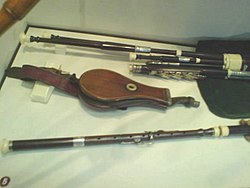 | |
| Other names | Union pipes |
|---|---|
| Classification | |
| Playing range | |
| 2 octaves | |
| Related instruments | |
The pastoral pipe (also known as the hybrid union pipes, organ pipe and union pipe) was a bellows-blown bagpipe, widely recognised as the forerunner and ancestor of the 19th-century union pipes, which became the uilleann pipes of today.[1][2][3] Similar in design and construction, it had a foot joint in order to play a low leading note and plays a two octave chromatic scale. There is a tutor for the "Pastoral or New Bagpipe" by J. Geoghegan, published in London in 1745.[4][5] It had been considered that Geoghegan had overstated the capabilities of the instrument, but a study on surviving instruments has shown that it did indeed have the range and chromatic possibilities which he claimed.[6]
- ^ Brian. E. McCandless. “The Pastoral Bagpipe” Iris na bPiobairi (The pipers review) 17 (Spring 1998), 2: p. 19-28.
- ^ W. Garvin. ‘The Complete Tutor for the Pastoral or New Bagpipe’, An piobaire v2 no 14pp 5-6; no 15pp 5-6;no 16pp 2-3 (1982-3)
- ^ P Roberts 'Unravelling the History of the Uilleann Pipes', Common Stock. vol no2 pp11-16 (1984)
- ^ J Geoghegan 'The Complete for the Pastoral or New Bagpipe', John Simpson, London (1746); at www.piob.infoc
- ^ R. Anderson. "The Pastoral Repertoire Rediscovered" (PDF). Cl.cam.ac.uk. Retrieved 12 January 2021.
- ^ "Ross's Music Page". Cl.cam.ac.uk. Retrieved 12 January 2021.